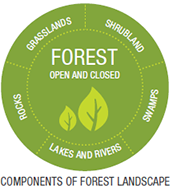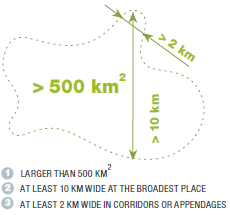|
Concept
Most of the world's original forests have either been lost to conversion or altered by logging and forest management. Forests that still combine large size with insignificant human influence are becoming increasingly important as their global extent continues to shrink.
There are several reasons to focus on large undeveloped forest areas:
- Ecosystems are generally better able to support their natural biological diversity and ecological processes the lower their exposure to humans and the greater their area. They are also better able to absorb and recover from disturbance (resistance and resilience).
- Large natural forest areas are important for the preservation of all strata of biological diversity. Fragmentation and loss of natural habitats are the main factors threatening plant and animal species with extinction. Large, roaming animals (such as forest elephants, great apes, bears, wolfs, tigers, jaguars, eagles, deer etc.) especially require that intact forest landscapes be preserved.
- Large natural forest areas are also important for maintaining ecological processes and supplying ecosystem services like water and air purification, nutrient cycling, carbon sequestration, erosion, and flood control.
- The conservation value of forest landscapes that are free from human disturbance is therefore high, although it varies among regions. At the same time the cost of conserving large unpopulated areas is often low. The same factors that have kept them from being developed, such as remoteness and low economic value, also help to reduce the cost of protecting them.
The concept of an Intact Forest Landscape (IFL) and its technical definition were developed to help create, implement, and monitor policies concerning the human impact on forest landscapes at the regional or country levels.
Definition

|
We define an Intact Forest Landscape (IFL) as an unbroken expanse of natural ecosystems within the zone of current forest extent, showing no signs of significant human activity and large enough that all native biodiversity, including viable populations of wide-ranging species, could be maintained. Although all IFL are within the forest zone, some may contain extensive naturally tree-less areas, including grasslands, wetlands, lakes, alpine areas, and ice. This definition builds on the definition of Frontier Forest that was developed by WRI (Bryant et al., 1997).
|
|
Technically, an Intact Forest Landscape (IFL) is defined as a territory within today's global extent of forest cover which contains forest and non-forest ecosystems minimally influenced by human economic activity, with an area of at least 500 km2 (50,000 ha) and a minimal width of 10 km (measured as the diameter of a circle that is entirely inscribed within the boundaries of the territory).
Areas with evidence of certain types of human influence are considered disturbed and consequently not eligible for inclusion in an IFL:
|

|
- Settlements (including a buffer zone of 1 km);
- Infrastructure used for transportation between settlements or for industrial development of natural resources, including roads (except unpaved trails), railways, navigable waterways (including seashore), pipelines, and power transmission lines (including in all cases a buffer zone of 1 km on either side);
- Agriculture and timber production;
- Industrial activities during the last 30-70 years, such as logging, mining, oil and gas exploration and extraction, peat extraction, etc.
Areas with evidence of low-intensity and old disturbances are treated as subject to "background" influence and are eligible for inclusion in an IFL. Sources of background influence include local shifting cultivation activities, diffuse grazing by domestic animals, low-intensity selective logging, and hunting.
IFL role in climate change mitigation
Woody, non-woody vegetation and soil within IFLs plays most important role in mitigating climate change by stabilizing terrestrial carbon storage and absorbing carbon dioxide from the atmosphere. Overall, forests and woodlands within IFL stored almost one-third (29%) of the total woody vegetation above ground carbon as of the year 2000 (based on the estimates by the Global Forest Watch). Tropical IFLs are most important as they alone comprise 23% of all carbon stored within all global forests. While remaining IFLs comprise only 20% of tropical forest area, they account for 40% of total aboveground tropical forest carbon and almost 50% of aboveground carbon within tropical rainforests alone (Based on the benchmark map of forest carbon stocks by Saatchi et al., 2011). The carbon storage density within tropical IFLs is almost three times higher compare to non-intact tropical landscapes (Saatchi et al., 2011).
IFLs in the boreal and temperate regions differ from those in the tropics by having lower biomass per unit area and lower productivity than managed forests. This has historical reasons. In the past, temperate and southern boreal forests have been cleared, converted into managed forests, or fragmented by infrastructure, leaving mostly low productivity forests (specifically, peatlands and mountains) as IFLs. Nevertheless, the vast areas of boreal IFLs represent a large and relatively stable aboveground and belowground carbon storage that plays an important role in the global climate system. While the recent increase in boreal wildfire frequency and intensity threatens long-term aboveground carbon storage in northern forests, it has been shown that IFLs have a lower fire frequency compared to fragmented and developed areas.
Because IFLs store disproportionally more carbon that non-intact landscapes, their degradation plays important role in carbon emissions. While fragmentation and alteration affected 7.2% of the year 2000 IFL area, the degraded portion of the IFLs stored 8.3% of the total IFL carbon (estimated by the Global Forest Watch). The disproportional carbon loss is even more evident in boreal regions. While IFL area decreased by 5.5% within boreal forests, this degraded area stored 8.4% of the aboveground carbon within boreal IFLs. This highlights the fact that in the boreal zone most of the degradation happens in the remaining high productivity forests that are most important as stable carbon pool.
Boreal soil carbon and permafrost protection is another important IFL function. Roads and pipelines construction have multiple direct and indirect effects on permafrost, increasing its vulnerability to thawing. Almost 52% (2.6 million km2) of the total continuous and discontinuous permafrost area within forest zone in North America and Eurasia is located within remaining IFLs.
|
|
|